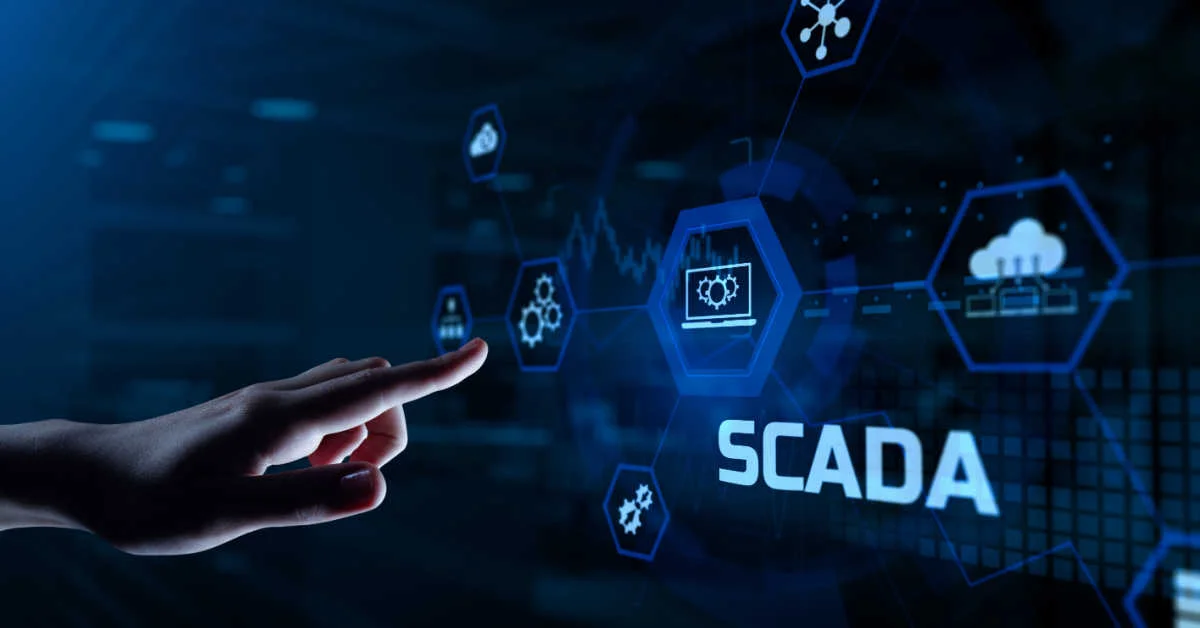SCADA stands for Supervisory Control and Data Acquisition. It’s a system architecture that uses computers, communication networks, and graphical user interfaces (HMI) to monitor and control industrial processes. This includes:
- Data Acquisition: Sensors and other devices collect real-time data from equipment and machinery.
- Data Monitoring: The SCADA system continuously monitors this data, presenting it to operators on the HMI in a clear and easy-to-understand format.
- Supervisory Control: Operators can use the HMI to control equipment remotely, sending commands to adjust settings or initiate actions.
Historical Role and Evolution:
Originally, SCADA systems were designed for remote data acquisition and monitoring over wide geographic areas. This was crucial for industries with geographically dispersed assets, like:
- Infrastructure: Telecommunications, transportation networks
- Utilities: Monitoring water treatment plants, pipelines, and power grids across vast regions.
- Oil and Gas: Overseeing pipelines, wellheads, and refineries spread across large distances.
The collected data was sent to a central computer for analysis and control decisions.
Modern SCADA Systems:
With advancements in technology, SCADA systems now perform more complex tasks, transforming from data collection hubs to intelligent control centers:
- Real-time Processing: Modern systems can process and analyze data in real-time, allowing for faster and more efficient decision-making. Operators can identify trends, predict potential issues, and take corrective actions before problems arise.
- Distributed Intelligence: Processing power can be distributed throughout the system, including on the plant floor itself with Remote Terminal Units (RTUs) and PLCs. This improves reliability and flexibility. If communication with the central system is disrupted, the local intelligence can take over critical operations until communication is restored.
- Human-Machine Interface (HMI): Modern HMIs are more user-friendly and provide operators with a wider range of information and control capabilities. They can display real-time data in various formats like graphs, charts, and mimic diagrams, allowing for easier identification of anomalies and trends. Additionally, HMI features like alarms and event notifications can help operators prioritize critical issues.
Benefits of SCADA Systems:
- Improved Efficiency: SCADA systems automate tasks, reduce errors, and optimize processes, leading to increased efficiency and productivity. Repetitive tasks can be automated, freeing up operators to focus on complex decision-making and problem-solving.
- Enhanced Control: Operators have a complete view of the process and can make informed decisions based on real-time data. This allows for proactive management and optimization of the entire process.
- Reduced Costs: SCADA systems can help to reduce operational costs by minimizing downtime, optimizing resource utilization, and enabling predictive maintenance. Early detection of equipment issues through real-time monitoring can prevent costly breakdowns.
- Improved Safety: By monitoring critical equipment and processes, SCADA systems can help to identify and prevent potential safety hazards. Real-time alarms can warn operators of abnormal conditions, allowing them to take corrective actions to prevent accidents and injuries.
System Components:
A SCADA system comprises two main parts:
- Hardware: Sensors, programmable logic controllers (PLCs), communication devices (RTUs, modems), and HMI consoles. Sensors collect data from physical equipment, PLCs perform pre-processing and basic control functions, communication devices transmit data, and HMI consoles provide visualization and control interfaces for operators.
- Software: SCADA software for data acquisition, monitoring, control, analysis, and HMI visualization. The software is the brain of the system, interpreting sensor data, managing communication, and presenting information to operators.
Communication Protocols:
SCADA systems use various communication protocols to ensure data exchange between different devices. Common protocols include Modbus, DNP3, and IEC 61850. Converters may be needed to connect devices with different communication protocols, ensuring seamless data flow across the entire system.
Conclusion
SCADA systems have become an essential part of modern industrial automation. They play a vital role in ensuring smooth operation, efficiency, and safety across various industries. As technology continues to evolve, SCADA systems will become even more sophisticated, integrating artificial intelligence and machine learning for further optimization and automation. This will lead to even greater efficiency, improved decision-making, and enhanced safety in industrial processes.






